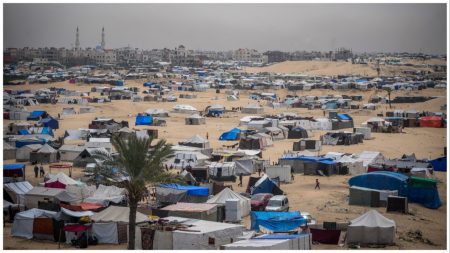By REBECCA SANTANA (Associated Press)
A judge has decided that migrant children waiting in makeshift camps along the U.S.-Mexico border for the Border Patrol to process them are considered to be in the agency’s custody, and are subject to a court-supervised agreement that sets standards for their treatment.
The timing of when the children officially enter Border Patrol custody is crucial due to a 1997 court settlement that outlines the treatment standards for migrant children in U.S. government custody. These standards include a limit on how long the children can be held and the provision of facilities such as toilets, sinks, and temperature controls.
Following Wednesday’s ruling, the Department of Homeland Security must promptly process the children and place them in facilities that are deemed “safe and sanitary.”
The border camps have become a point of contention between immigrant advocates and the federal government. The U.S. asserts that smugglers send migrants to the camps, and argues that the children are not yet in Border Patrol custody because they have not been arrested. Advocates claim that the U.S. government is responsible for the children and that Border Patrol often directs migrants to the camps, sometimes even driving them there.
Unaccompanied children must be transferred to the U.S. Health and Human Services Department within 72 hours of arrival. This agency typically releases them to family in the United States while an immigration judge considers asylum. Asylum-seeking families are generally released in the U.S. while their cases go through the courts.
Neha Desai, senior director of immigration at the National Center for Youth Law, expressed satisfaction at the ruling, but highlighted that it is distressing that a court had to instruct the government to do what basic human decency and the law clearly demand. Desai expects CBP to promptly comply with the court’s order and remains committed to holding CBP responsible for meeting the most basic needs of children in their legal custody, including food, shelter, and basic medical care.
The Department of Homeland Security did not immediately respond to a request for comment.
U.S. District Judge Dolly Gee’s ruling could have significant implications due to the changing demographics of individuals coming to the United States. In the past, the typical individual attempting to enter the U.S. was an adult male from Mexico seeking work. Now, families with children are increasingly undertaking dangerous journeys to the border in search of a new life. Caring for children places different pressures on federal agencies that have historically been more focused on adults.
The legal challenge centers on two areas in California: one between two border fences in San Diego, and another in a remote mountainous region east of San Diego. Migrants who cross the border illegally wait outdoors or in makeshift shelters made of tree branches while lacking sufficient food and water. When the number of migrants was particularly high last year, they waited for several days for Border Patrol agents to arrest and process them.
Gee stated that there is strong evidence showing that Customs and Border Protection, including Border Patrol, has physical control over children at outdoor locations. For example, CBP vehicles sometimes bring or leave migrants at the camps and, for a period, used wristbands to organize migrants based on their arrival time.
During a hearing on March 29, the Justice Department mentioned that any agent who transports or accompanies migrants to the camps is considered similar to a law enforcement officer directing traffic to prevent disorder.
The judge decided that the Customs and Border Protection’s juvenile coordinator must keep records of minors held in the agency’s custody for more than 72 hours, including their time spent in the camps. The agency must ensure that the treatment of minors at open-air sites complies with the 1997 agreement, as stated by Gee.
Gee set a deadline of May 10 for the juvenile coordinator to submit an interim report on the number of minors held in open-air sites and the agency's compliance with the judge's order.









